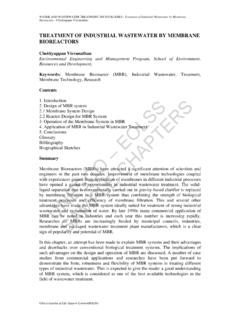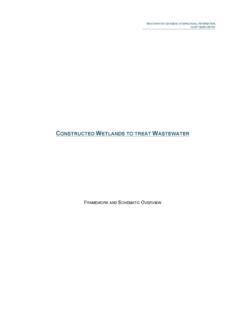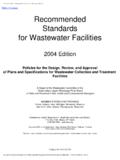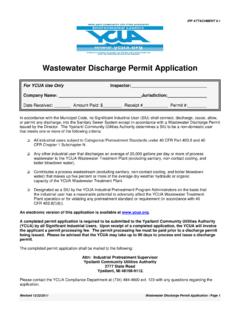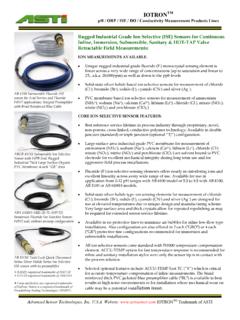Transcription of Filtration Technologies in Wastewater Treatment
1 UNESCO EOLSSSAMPLE CHAPTERSWATER AND Wastewater Treatment Technologies - Filtration Technologies in Wastewater Treatment - S. Vigneswaran, J. Kandasamy and M. Rogerson Encyclopedia of Life Support Systems (EOLSS) Filtration Technologies IN Wastewater Treatment S. Vigneswaran, J. Kandasamy and M. Rogerson Faculty of Engineering and Information Technology, University of Technology, Sydney Keywords: Deep bed Filtration , rapid filters, direct Filtration , microfiltration, precoat Filtration , cartridge Filtration Contents 1. Introduction 2. Deep bed Filtration Rapid Filters Direct Filtration Design Principles Advantages and Limitations Performance of Deep Bed Filtration in Wastewater Treatment 3. Other Filtration Technologies Microstraining Precoat Filtration Cooking oil Filtration Fibres from Highly Pure Cellulose Cartridge Filters Filtration Mechanism Application of Cartridge Filters Performance Glossary Bibliography Biographical Sketches Summary This chapter commences with a discussion on the use of deep bed Filtration in Wastewater Treatment .
2 Deep bed Filtration includes rapid filters and direct filters. Rapid Filtration is used as the final clarifying step in municipal water Treatment plants. There are two types of rapid sand filters; the gravity and pressure types. Conventional water Treatment plants generally use unit operations such as rapid mixing, flocculation, sedimentation, Filtration , and disinfection. Depending on the quality of the water, one or more unit operations can be eliminated, thereby achieving a cost-effective water Treatment . Direct Filtration is one such method. Filters used in direct Filtration thus differ little from those for conventional Treatment in construction. The primary difference is related to solids storage capacity and backwashing requirements. Other related Filtration Technologies such as cartridge Filtration , microstrainer, precoat Filtration are also discussed and evaluated.
3 UNESCO EOLSSSAMPLE CHAPTERSWATER AND Wastewater Treatment Technologies - Filtration Technologies in Wastewater Treatment - S. Vigneswaran, J. Kandasamy and M. Rogerson Encyclopedia of Life Support Systems (EOLSS) 1. Introduction This chapter commences with a discussion on the use of deep bed Filtration in Wastewater Treatment and introduces other related Filtration Technologies such as cartridge Filtration , microstrainer, precoat Filtration . 2. Deep Bed Filtration Deep bed Filtration processes have been used in industrial and municipal Wastewater Treatment , in combination with other unit operations, such as activated sludge, chemical coagulation, oxidation, reduction and ion exchange, etc. The structure of the filter for industrial Wastewater Treatment is virtually the same as that used for potable water Treatment .
4 The filters used in domestic and industrial Wastewater Treatment are generally made of steel instead of reinforced concrete, to facilitate the movement of the units during augmentation of the Treatment facility. Rapid Filters Rapid Filtration is used as the final clarifying step in municipal water Treatment plants. Flocculation and sedimentation is provided as pretreatment units to the rapid filter if the raw water has turbidity in excess of 10-20 NTU for an efficient process. There is practically no biological action in rapid Filtration although some nitrification occurs where the Filtration velocity is relatively slow, where the oxygen content is adequate, and where the nitrifying bacteria find favorable nutrients in the water. Table 1 gives the characteristics of the gravity type rapid filters.
5 A diagrammatic section view of a rapid gravity filter is given in Figure 1 (modified from Cowle, 1991). The filter operates usually 24-36 hours before attaining turbidity breakthrough. When the filter is in Filtration mode the influent water passes through the filter medium, the supporting layer, and the underdrain where it experiences an energy loss due to frictional resistance referred to as headloss. When the headloss becomes excessive and beyond m, the filter should be cleaned. During cleaning, the water above the filter is drained until the water lies a few centimeters above the top of the bed when air from a compressed air unit is blown in reverse to the normal flow direction at a rate of about m3 free air/m2 of bed area, at a pressure of 20-35 kN/m2, for about 2-3 minutes, Figure 2 (modified from Cowle, 1991).
6 The water over the bed quickly becomes very dirty as the air agitates the sand and breaks up and detaches the surface scum and dirt. Following this an upward flow of water is passed through the bed at a velocity high enough to sufficiently expand the bed by about 20-50% and cause the sand grains to be agitated and allow scale and deposits to be washed off them, but not at a velocity so high that the sand grains are carried away in the rising upward of water. The details on the filter operation and cleaning can be found elsewhere, (Vigneswaran and Visvanathan, 1995). UNESCO EOLSSSAMPLE CHAPTERSWATER AND Wastewater Treatment Technologies - Filtration Technologies in Wastewater Treatment - S. Vigneswaran, J. Kandasamy and M. Rogerson Encyclopedia of Life Support Systems (EOLSS) Figure 1 Diagrammatic section of a rapid sand filter.
7 The entire process of backwashing the filters and restarting the water supply takes about 15 minutes. The specified minimum backwash time for a rapid filter is 5 minutes. The amount of water required to wash a rapid filter may vary from 3-6% of the total amount of water filtered. Upward washwater rates are usually of the order of m/min. The different filter backwash methods and the recommended design values are summarised in Table 2. Figure 2 Diagrammatic section of a backwash system. Characteristic Rapid filter Filtration rate 120-360 m3/m2d Size of bed Small (100 m2) Depth of bed 500 mm gravel, m sand, stratified; in some cases sand and anthracite are used as dual media Effective size of sand mm Uniformity coefficient UNESCO EOLSSSAMPLE CHAPTERSWATER AND Wastewater Treatment Technologies - Filtration Technologies in Wastewater Treatment - S.
8 Vigneswaran, J. Kandasamy and M. Rogerson Encyclopedia of Life Support Systems (EOLSS) Head loss Up to 3 m Length of run 1-2 days Method of cleaning Backwash with water and air + water scour and in some cases surface scour Washwater consumption 3-6% of filtered water Penetration of suspended solids through the filter bed Deep Pretreatment by coagulation Yes Covered construction Optional Visible operation Yes Adjusting the quality of filtrate Can be done quickly Bacteria removal 90-99% Table 1 Comparison of Slow Sand Filters and Rapid Sand Filters Water backwash with air auxiliary Parameter High-rate water backwash Air scour followed by high-rate water backwash Simultaneous air and low-rate water backwash followed by high-rate water backwash Water backwash with surface wash auxiliary Backwash rate m3/m2h >18 m3/m2h 15-18 m3/m2h Backwash
9 Water kg/cm2 kg/cm2 kg/cm2 kg/cm2 pressure Air scour rate 27 m3/m2h 36-46 m3/m2h Surface wash rate 10 12 m3/m2h Pressure of surface 4 kg/cm2scour water This type of filter backwash is used when mud ball formation occurs on the top of filter bed Porosity range during expansion Expansion of medium 80-100% Low Low Time of washing 3-6 mm 3-4 mm 2-3 mm Time of air scour 3-4 mm 2-3 mm application UNESCO EOLSSSAMPLE CHAPTERSWATER AND Wastewater Treatment Technologies - Filtration Technologies in Wastewater Treatment - S.
10 Vigneswaran, J. Kandasamy and M. Rogerson Encyclopedia of Life Support Systems (EOLSS) Amount of wash High High High High water needed Efficiency of cleaning Poor Good Good action Applicability Single and multimedia filters Single and multimedia filters Single and multimedia filters Single media filters Table 2 Recommended Design Values for Various Backwash Methods The media size (D) and depth (L) of filter media depends on the raw water quality and the required filter run. The ratio of L/D is usually in the range of 800-1000 for potable water Treatment . However, in Wastewater Treatment , a lower L/D ratio of between 500-700 is common.











